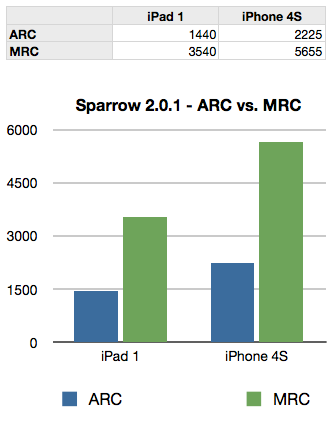Daniel Sperl, developer of the Sparrow Framework, recently posted a performance comparison on the Apple Developer forum where Sparrow ran 2.5 times faster with MRC code than the version upgraded to ARC.
A curious finding though it seemed very far off from real world observations. Being a synthetic benchmark no less. I decided to do a similar test based on the same code comparing cocos2d v2 and v3.
Fortunately cocos2d-iphone v3 has made a similar switch from MRC (v2.1 and earlier) to ARC (v3 preview). Unfortunately the internals of cocos2d also changed to some extent, for example custom collection classes written in C were replaced by Core Foundation classes. I don’t have a full overview of the changes, but at least the renderer doesn’t seem to have changed in any significant way. Yet.
So while comparability is good, it’s not like Sparrow where truly the only changes made were converting the code from ARC back to MRC. Take the following benchmark results and comparisons with two grains of salt and pepper on the side.
ARC vs MRC
The original benchmark done with Sparrow has seen MRC perform 2.5 times better than ARC in a synthetic “draw as many sprites as possible until framerate has dropped consistently below 30 fps” test:
A new episode of the Cocos2D Podcast is now live. This time we’re joined by Daniel Sperl, author of the Sparrow Framework Objective-C game engine for iOS which is based on the ActionScript (Flash) API design.
Note: the Sparrow website is currently reported as “possibly malware” by Safari and Google. The culprit has been removed and the site is safe to visit. Read this blog post for more info about what happened.
Daniel has a secret he shared with us even though he couldn’t really say any details until the official announcement in a few weeks. Cocos2D also gets a couple honorable (or dishonorable) mentions as we compare it with Sparrow Framework, and come to the conclusion that documentation-wise it is leaps and bounds ahead of Cocos2D.
Cocos2D Podcast: Daniel Sperl (Sparrow Framework Developer)
Previous Cocos2D Podcast: Marketing your App
I forgot to blog about the previous Cocos2D Podcast in which Azam and I talk about marketing your iPhone app.
Cocos2D Podcast: Marketing your iPhone App
Unrelated but important: Steve Jobs resigns
In case you haven’t heard, Steve Jobs has resigned as CEO of Apple on August 24th, 2011. Here’s Steve’s (short and to the point) letter to the Board of Directors. Tim Cook was named as his successor. Read the press release.
I never really cared for who’s boss of a big company, just enough to get the ridicule. But Steve Jobs leaving .. I can’t help but feel sad.
I believe this is for one reason in particular: very, very few CEOs actually have a vision and follow it through. Or have the (will)power to follow it through without being bent or influenced through challenges and oppositions by corporate and outside politics. Steve was able to retain all of the drive, dedication and willpower that you have when you just start out as a company or individual trying to make a really great product that you believe in and want to be proud of.
Most large companies are simply unable to create such products because too many people work on each product, and there’s lots of money and risk involved in the process which, more often than not, turns potentially great companies into conservative, boring companies making lackluster products, following consumer trends. Apple under Steve Jobs has been the exception. Steve has repeatedly anticipated consumer trends, even created them through the power that is the Apple brand.
The really, really sad part however is what hasn’t been said. Steve being unable to meet his duties paints a grim outlook on his health. Not mentioning his health in his letter and Apple’s press release even more so. I just wish for him that it’s not as bad as one can imagine it to be if it forces someone of Steve’s caliber to resign from his position. Good luck and all the best, Steve!












